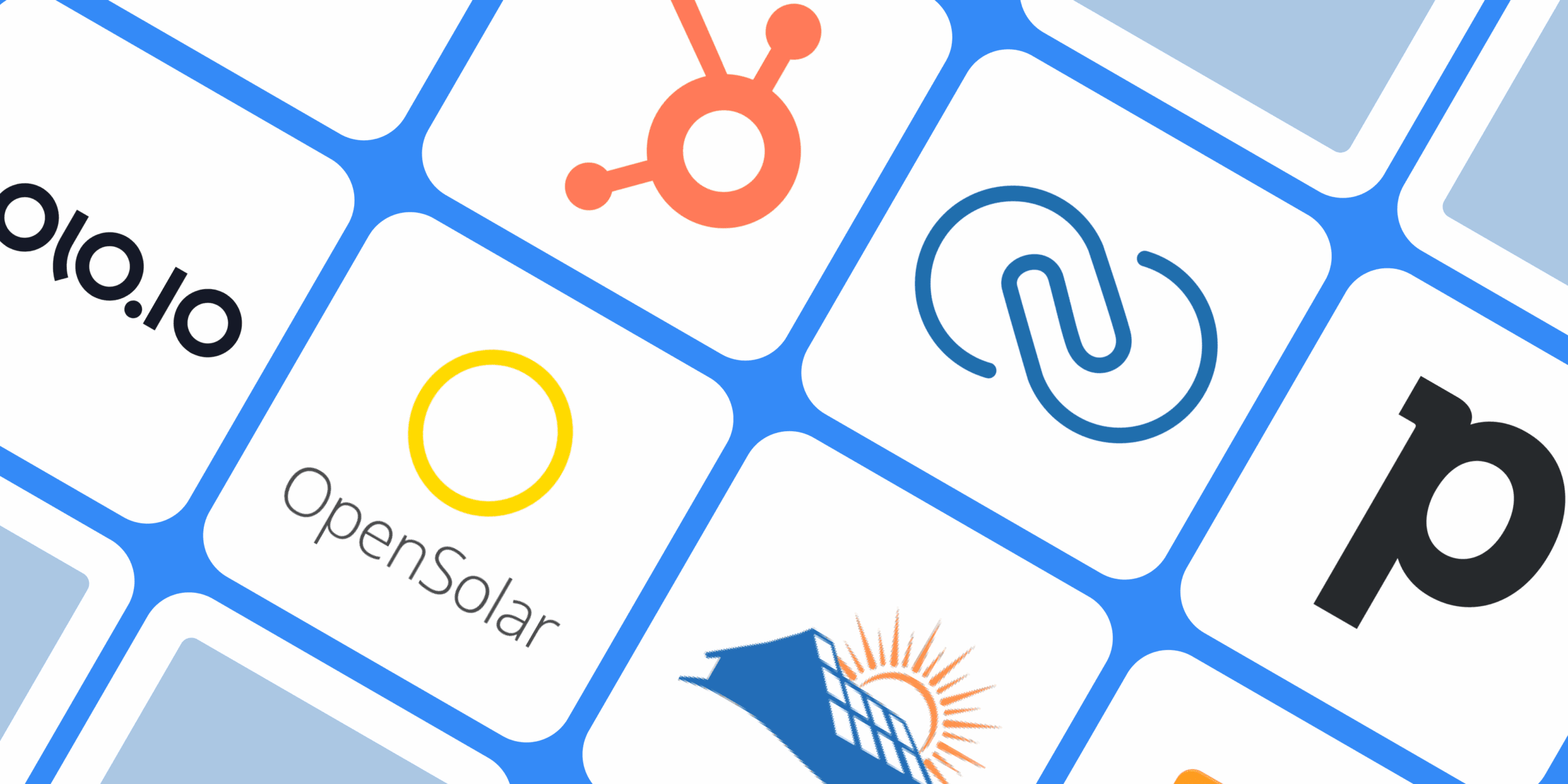
The solar industry has emerged as one of the most rapidly expanding sectors in renewable energy. The US solar industry installed 10.8 gigawatts of direct current (GWdc) capacity in the first quarter of 2025 alone.
This remarkable growth trajectory, characterized by solar accounting for 69% of all electric generating capacity added to the U.S. grid in Q1 2025, has created unprecedented opportunities and challenges for solar businesses simultaneously. As companies adapt to this dynamic environment, implementing Customer Relationship Management (CRM) systems has become essential for sustainable success.
The Essence of CRMs for Solar Businesses
A specific CRM is a basic need for solar businesses to accommodate the industry’s unique characteristics, including extended sales cycles, complex project management requirements, and financing arrangements. These systems serve the businesses for good by orchestrating customer interactions, project workflows, and business intelligence in a cohesive framework.
According to GTM Research, acquiring a solar customer costs approximately 49 cents per watt in the U.S., equating to roughly $3,000 for a typical 6-kilowatt residential rooftop installation. This substantial investment in customer acquisition underscores the critical importance of optimizing every aspect of the customer journey through sophisticated CRM implementation. |
Features to Consider in a CRM
Solar companies have unique needs, but most CRMs share several core features that help solar sales and operations run smoothly.
The key capabilities include:
Lead and Deal Tracking: A solar CRM should track every lead and opportunity through the sales pipeline. The system records their source and status as leads come in (from the website, referrals, events, etc.). Sales reps can then see a visual pipeline of deals in progress.
Proposal and Quote Generation: Solar projects require detailed proposals. Few CRMs automatically generate quotes based on your pricing rules and system designs. Some solar CRMs include built-in proposal builders and templated quote documents.
Project & Job Management: Beyond sales, a solar CRM often includes project management features. This means tracking the installation process (site surveys, permitting, equipment procurement, etc.) and key milestones.
Customer Communication & Follow-Up: Solar installations can span months, so consistent communication is critical. A CRM centralizes email, phone calls, and meeting notes for every customer. It also automates follow-ups and reminders.
Integrations with FSM: Solar workflows heavily rely on field service management software to manage their field operations. So, it is essential to look for CRMs that integrate with your field operation software.
Choosing the Best CRM for a Solar Business
Choosing the right CRM depends on your business size, budget, and needs. For this, key considerations include ease of use, customization, feature set, and pricing, by and large. Let’s get into the nitty gritty of how to choose the right CRM for your solar business:
Salesforce vs HubSpot
Salesforce and HubSpot are two popular platforms. Let’s have a side-by-side comparison of defining features, scope, and much more.
| Feature | Salesforce | HubSpot |
|---|---|---|
| Sales Reporting & Forecasting | Advanced reporting, basic in baseline plans | Advanced reporting in the upgraded paid plan |
| Ease of Use | Easy to use with quick browser setup | Intuitive and user-friendly interface |
| Customization | Extensive, requires technical expertise; low-code tools available | Good for startups and enterprise-level customization |
| AI Integration | Agentforce AI, predictive & generative automation | Breeze AI with agents for sales, content & support |
| Integrations | Vast ecosystem, a bit complex setup | Extensive and easier implementation |
| Automation Features | Advanced sales automation | Strong marketing automation |
| Support & Onboarding | Extensive partner network | Self-service focused |
| Implementation Time | 3–12+ months | 1–3 months |
| Pricing | $25/month/seat | $20/month/user |
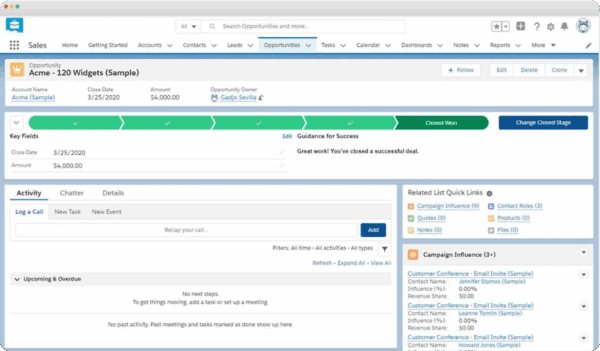
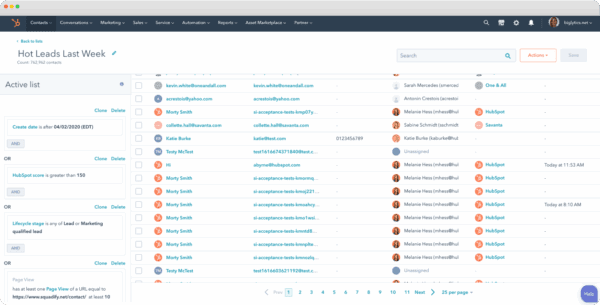
Interesting Thread: Salesforce vs HubSpot
(The Reddit thread discussing Salesforce vs HubSpot reveals a nuanced debate where users generally acknowledge that Salesforce is more powerful and customizable, making it suitable for larger enterprises with complex sales processes. However, many highlight that HubSpot offers a more user-friendly interface and easier setup, which appeals to small and medium-sized businesses or teams looking for quick deployment without heavy customization. Cost is a recurring theme, with Salesforce often seen as more expensive and requiring dedicated admin resources, whereas HubSpot’s pricing model and integrated marketing tools provide a more accessible entry point. Overall, the consensus is that Salesforce excels in scalability and advanced features, while HubSpot shines in simplicity and ease of use, making the choice largely dependent on organizational size, budget, and specific CRM needs.)
Recommendation:
In short, Salesforce shines with customizability and reporting for large-scale operations, whereas HubSpot CRM is simpler and more plug-and-play, suiting smaller installers and teams who value ease and built-in marketing tools. Many experts note that migrating to Salesforce from HubSpot can be complex, so it’s wise to start with the platform that best matches your scale and budget from the outset.
Zoho CRM vs Pipedrive
Below, we brief overview of Zoho and Pipedrive used by solar businesses in general, noting each one’s focus, strengths/limits, and pricing:
| Aspect | Zoho CRM | Pipedrive |
|---|---|---|
| Features | Multi-channel (email, phone, chat, social), analytics, AI (Zia), automation, territory management, custom modules | Visual pipeline, unlimited deals, mobile app, basic automation, AI Sales Assistant, simple reporting |
| Integrations | Strong and smooth | Good and convenient |
| Ease of Use | Feature-rich, intuitive, and customizable | Extremely intuitive, fast setup, ideal for CRM beginners |
| Customization | Custom modules, fields, workflows; limited interface tweaks | Visual pipeline customization; fewer deep options |
| Analytics / Reporting | Advanced dashboards, strong analytics in higher tiers | Real-time analytics; AI-assisted reporting and goal tracking |
| AI Use | Extensive use of Zia bot as a conversational assistant | Strong AI for sales, email, and AI-powered marketplace |
| Best For | All-in-one, affordable CRM with analytics | Small teams needing visual sales tracking & quick onboarding |
| Support | Good, but slow at peak times | 24/7 chat support on all plans |
| Pricing | Free tier (3 users, limited); Paid: $14–$52/user/month | No free tier; $14–$79/user/month, 30-day trial |
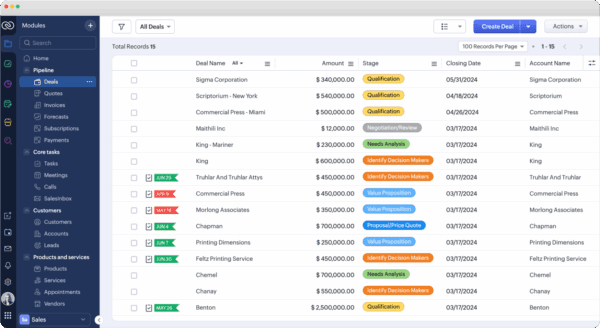
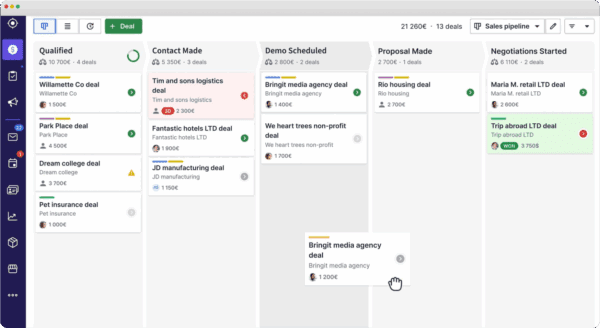
Top Solar-Specific CRM Solutions
Solo (Solar CRM)
A solar-specific CRM/operations platform (formerly SolarNexus) is designed exclusively for installers. Solo’s CRM is part of a full solar growth suite that covers sales proposals, engineering, and project management.
Key Features: The key features include:
- Lead and proposal management
- Project milestones tracking
- Automated task assignments
- Customer communications
- Document storage
- Change orders
Limitations: Solo is one of the most expensive options, targeting mid-range to large installers. Pricing is custom and usage-based. Because it’s a full-suite solution, implementation can take time (with onboarding fees).
OpenSolar CRM
OpenSolar is a free cloud-based platform combining PV design, sales, finance, and CRM. It’s aimed at installers who want a cost-free end-to-end tool. The CRM is built-in; however, you can optionally integrate any other CRM via API.
Key Features:
- Lead, contact, and project management (all free)
- One-click calls/emails to customers
- Digital scheduling and calendar integration
- Custom workflows and project statuses
Limitations: As a free product, it lacks the final touches of paid tools. Customization is good, but less powerful than enterprise CRMs. Reporting and advanced features are more limited (for example, in-depth analytics are minimal). Customer support is mainly community-driven. However, it gets frequent updates and is backed by a growing user base.
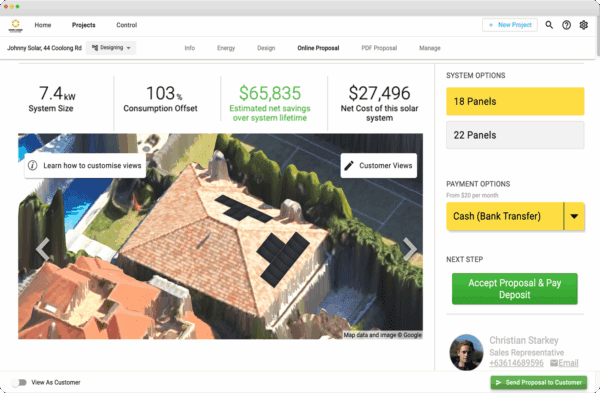
SolarCRM
A lightweight, solar-focused CRM created specifically for rooftop solar installers. It streamlines the sales process from inquiry to installation. It is marketed as “simple, light, and 10x cheaper” than generic CRMs for solar companies.
Key Features:
- Preconfigured solar sales process (leads ➔ surveys ➔ design ➔ proposal)
- End-to-end tracking on a central dashboard
- Built-in site survey form and photo capture tools
- Customizable proposal templates and pricing calculations
- Live team monitoring and email alerts
Limitations: It lacks some bells and whistles of bigger CRMs (no native marketing tools or advanced analytics). Third-party integrations only become a part with higher plans.
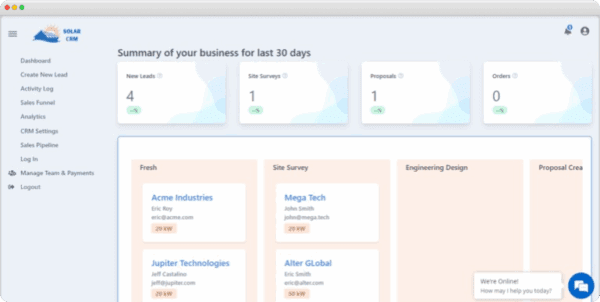
Solargraf
Solargraf is primarily a solar design and proposal platform rather than a general CRM. It combines 3D PV design tools, detailed quotes, and integrated financing and permit solutions. While it isn’t a full CRM, it replaces many design workflows and connects directly with customers via e-signature.
Key Features:
- Laser Roof Measurement
- Auto Shade Calculation
- Branded Proposals
- Auto Permit Plans
- Multiple Financing Options
Limitations: Solargraf does not manage leads or projects beyond design. You would still need a CRM or spreadsheet for pipeline management. Pricing is relatively high compared to basic CRMs. It does not include marketing or post-sale service features.
Each of the above CRMs can serve solar businesses, but the best choice depends on your context. Large enterprises with complex processes may lean toward Salesforce or Zoho, fast-growing businesses might prefer HubSpot or Pipedrive, and solar-specialized firms should evaluate Solo, OpenSolar, or SolarCRM. Regardless of platform, it is important to focus on the features and usability that matter most for your team.
Final Verdict
The right CRM empowers solar businesses to streamline sales, enhance customer relationships, and accelerate project execution. Additionally, the real advantage emerges when it’s integrated with effective field service management software. This connection bridges the gap between office teams and field crews, enabling real-time scheduling, automated task assignments, and seamless data flow from lead to installation.
Frequently Asked Questions
Solar businesses have unique needs, such as long sales cycles, complex project management, and financing arrangements that generic CRMs may not address effectively.
A CRM sales cycle refers to the structured process a business follows to convert leads into customers using a CRM platform. It covers every stage from capturing leads, qualifying them, understanding their needs, generating quotes, managing negotiations, closing deals, and following up for customer retention.
Not all CRMs come with native quotation tools. While platforms like Salesforce, Zoho CRM, and HubSpot offer built-in or add-on quoting features, others rely on integrations with third-party apps.
Integrations, especially with field service management tools, streamline operations by connecting office teams with field crews, enabling real-time scheduling and task automation.
The standard CRM sales cycle includes:
- Lead Generation
- Lead Qualification
- Needs Analysis
- Quote or Proposal Generation
- Negotiation and Objection Handling
- Deal Closing
- Post-Sale Follow-up and Customer Management
Yes, advanced CRM systems can track customer relationships beyond the initial sale. But the accuracy lies in integrating with scheduling software. They log post-sale communications, onboarding activities, and service tickets. This long-term visibility helps improve customer retention and lifetime value.
